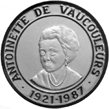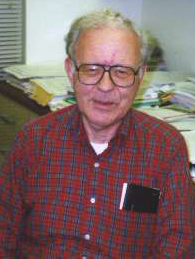The 2010-2011 Antoinette de Vaucouleurs
Memorial Lectureship and Medal
Chemical Abundances in the Oldest Galactic Stars: Globular Clusters vs. the Halo Field
Dr. Robert P. Kraft
Professor Emeritus of Astronomy and Astrophysics,
University of California, Santa Cruz
&
Astronomer Emeritus,
UC Observatories/Lick Observatories
Tuesday, March 1, 2011

PROGRAM
Reception ~ RLM 15.216A, 3:00 PM
Reception, with snacks and beverages, in the Edmonds Lounge
Presentation ~ RLM 15.216B, 3:30 PM
Presentation of the Antoinette de Vaucouleurs Medal to Robert Kraft by Neal Evans, Chairman, Department of Astronomy
Lecture ~ RLM 15.216B, 3:33 PM
Antoinette de Vaucouleurs Colloquium by Robert Kraft: “Chemical Abundances in the Oldest Galactic Stars: Globular Clusters vs. the Halo Field
abstract
This is a review of the quest to determine the chemical
abundances of the oldest stars in the Galaxy, the members
of the halo field and globular cluster populations. From
forty years of spectroscopic studies, it appears that
cluster and field stars are not chemically identical
but differ significantly especially in the behavior of
O, Na, Mg and Al. We explore both deep mixing and primordial
abundance variations as explanations for these differences,
and find that both are needed. The unusual abundance ratios
of the Mg isotopes found in some clusters points to the
importance of a primordial "pollution" scenario involving
the output of intermediate mass AGB (asymptotic mass branch)
stars. We discuss briefly scenarios for the formation of
the Galactic halo.
Wednesday, March 9, 2011
Presentation ~ RLM 15.216B, 12:00 Noon
Stellar Seminar Presentation by Robert Kraft: “Title: TBA”
About Dr. Kraft
Dr. Kraft received his M.S. at the University of Washington, and his PhD at the University of California, Berkeley. He has taught Mathematics at Whittier College, Astronomy at the University of Indiana and the University of California, Santa Cruz. He has done research at the Mt. Wilson Observatory, the Yerkes Observatory, and the Mt. Palomar Observatory. He is presently Professor Emeritus of Astronomy and Astrophysics at the University of California, Santa Cruz, and Astronomer Emeritus at the University of California Observatories/Lick Observatory.
In earlier parts of his career he did pioneering work on Cepheid variables and novae. In a series of papers published during the 1960s, Kraft showed that novae and dwarf novae are all binary stars, most with orbital periods between a few hours and a day. This result is the foundation for all subsequent research on these stars.
Dr. Robert Kraft is responsible for much of what we know about the metal-poor populations of the Milky Way, both globular clusters and halo field stars, and has been a major figure in establishing observational constraints on the chemical evolution of galaxies. Until recently, these were the lowest metallicity stars known, and they still remain key to understanding the formation and evolution of the Galaxy. His discoveries of variability in the abundances of light elements in globular clusters has led directly to current research on multiple generations of stars in the clusters.
Dr. Kraft has served successful tenures as director of Lick Observatory, President of the AAS, and President of the IAU. He received the Helen B. Warner Prize in 1962, and continued to make major contributions, for which he was awarded the Henry Norris Russell prize in 1995, and the ASP’s Bruce Medal for a lifetime of achievement in astronomy in 2005. He continues to participate in cutting-edge observational studies of globular cluster stars. His group is now engaged in a pilot study of the use of moderate-resolution multi-object spectra to investigate the elemental abundance distribution from globular cluster main sequences through the red giant domains.
More..

Dr. Robert Kraft